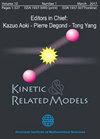广义加权有向图上cucker - small和Motsch-Tadmor模型的概率聚类
IF 1.5
4区 数学
Q1 MATHEMATICS
引用次数: 0
摘要
. 本文讨论了具有一般通信函数的一般有向加权图上连续时间Cucker-Smale和Motsch-Tadmor模型的羊群现象。我们提出了一种基于解的概率解释的新方法来研究这个问题。我们在相互作用矩阵的四个假设下给出了群集结果,并强调了它们与某马尔可夫跳变过程的总变分收敛的关系。实际上,我们在图中允许唯一封闭通信类的最小情况下改进了先前的结果。考虑邻接矩阵置乱和存在正可逆措施的两种特殊情况,改进了最小情况下的群集条件。在最后一种情况下,我们描述了渐近速度。我们还研究了等级领导情况,给出了一个新的一般羊群条件,该条件允许处理ψ (r)∝(1 + r 2) - β/ 2和β≥1的情况。对于层级领导假设下的Motsch-Tadmor模型,我们展示了无论初始条件和通信函数如何,特别是当β≥1时,都会发生群集现象的情况。本文章由计算机程序翻译,如有差异,请以英文原文为准。
Flocking of the Cucker-Smale and Motsch-Tadmor models on general weighted digraphs via a probabilistic method
. In this paper, we discuss the flocking phenomenon for the Cucker-Smale and Motsch-Tadmor models in continuous time on a general oriented and weighted graph with a general communication function. We present a new approach for studying this problem based on a probabilistic interpretation of the solutions. We provide flocking results under four assumptions on the interaction matrix and we highlight how they relate to the convergence in total variation of a certain Markov jump process. Indeed, we refine previous results on the minimal case where the graph admits a unique closed communication class. Considering the two particular cases where the adjacency matrix is scrambling or where it admits a positive reversible measure, we improve the flocking condition obtained for the minimal case. In the last case, we characterise the asymptotic speed. We also study the hierarchical leadership case where we give a new general flocking condition which allows to deal with the case ψ ( r ) ∝ (1 + r 2 ) − β/ 2 and β ≥ 1. For the Motsch-Tadmor model under the hierarchical leadership assumption, we exhibit a case where the flocking phenomenon occurs regardless of the initial conditions and the communication function, in particular even if β ≥ 1.
求助全文
通过发布文献求助,成功后即可免费获取论文全文。
去求助
来源期刊
CiteScore
2.10
自引率
10.00%
发文量
36
审稿时长
>12 weeks
期刊介绍:
KRM publishes high quality papers of original research in the areas of kinetic equations spanning from mathematical theory to numerical analysis, simulations and modelling. It includes studies on models arising from physics, engineering, finance, biology, human and social sciences, together with their related fields such as fluid models, interacting particle systems and quantum systems. A more detailed indication of its scope is given by the subject interests of the members of the Board of Editors. Invited expository articles are also published from time to time.

 求助内容:
求助内容: 应助结果提醒方式:
应助结果提醒方式:


